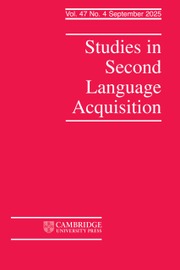Crossref Citations
This article has been cited by the following publications. This list is generated based on data provided by
Crossref.
Hedgcock, John
1991.
Foreign Language Retention and Attrition: A Study of Regression Models.
Foreign Language Annals,
Vol. 24,
Issue. 1,
p.
43.
de Bot, Kees
1992.
Metalinguistic awareness in Dutch immigrants
.
Australian Review of Applied Linguistics,
Vol. 15,
Issue. 2,
p.
19.
Kuhberg, Heinz
1992.
Longitudinal L2-attrition versus L2-acquisition, in three Turkish children- empirical findings.
Interlanguage studies bulletin (Utrecht),
Vol. 8,
Issue. 2,
p.
138.
Baker, Rosemary
1993.
The assessment of language impairment in elderly bilinguals and second language speakers in Australia.
Language Testing,
Vol. 10,
Issue. 3,
p.
255.
de Bot, Kees
and
Clyne, Michael
1994.
A 16‐year longitudinal study of language attrition in Dutch immigrants in Australia.
Journal of Multilingual and Multicultural Development,
Vol. 15,
Issue. 1,
p.
17.
Obler, Loraine K.
and
Hannigan, Sharon
1996.
Handbook of Second Language Acquisition.
p.
509.
Noguchi, Sachiko
1998.
Returning to the homeland.
Australian Review of Applied Linguistics. Series S,
Vol. 15,
Issue. ,
p.
105.
Clyne, Michael
2003.
Dynamics of Language Contact.
Schmid, Monika S.
and
de Bot, Kees
2004.
The Handbook of Applied Linguistics.
p.
210.
Keijzer, Merel
2004.
First language attrition: A cross-linguistic investigation of Jakobson's regression hypothesis.
International Journal of Bilingualism,
Vol. 8,
Issue. 3,
p.
389.
Ecke, Peter
2004.
Language attrition and theories of forgetting: A cross-disciplinary review.
International Journal of Bilingualism,
Vol. 8,
Issue. 3,
p.
321.
Bolonyai, Agnes
2007.
(In)vulnerable agreement in incomplete bilingual L1 learners.
International Journal of Bilingualism,
Vol. 11,
Issue. 1,
p.
3.
JESSNER, ULRIKE
2008.
A DST Model of Multilingualism and the Role of Metalinguistic Awareness.
The Modern Language Journal,
Vol. 92,
Issue. 2,
p.
270.
BROERSMA, MIRJAM
2009.
Triggered codeswitching between cognate languages.
Bilingualism: Language and Cognition,
Vol. 12,
Issue. 4,
p.
447.
Sharifian, Farzad
and
Sussex, Roland
2010.
Michael George Clyne (1939–2010): scholar and champion of languages.
Current Issues in Language Planning,
Vol. 11,
Issue. 4,
p.
371.
Bardovi-Harlig, Kathleen
and
Stringer, David
2010.
VARIABLES IN SECOND LANGUAGE ATTRITION.
Studies in Second Language Acquisition,
Vol. 32,
Issue. 1,
p.
1.
Unganer, Tulin
2014.
First Language Loss; Why Should We Care?.
Procedia - Social and Behavioral Sciences,
Vol. 158,
Issue. ,
p.
351.
Reubold, Ulrich
and
Harrington, Jonathan
2015.
Language Development.
Vol. 37,
Issue. ,
p.
9.
Seritan, Andreea L.
and
Espinoza, Randall
2016.
International Medical Graduate Physicians.
p.
203.
Seton, Bregtje
and
Schmid, Monika S.
2016.
The Cambridge Handbook of Linguistic Multi-Competence.
p.
338.

